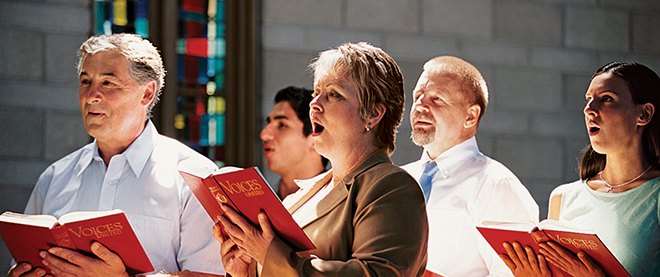Church: The happiest place on earth
A new study says those who get out to church regularly on Sundays are less likely to be depressed
Rob Melnychuk/Getty Images
Share

“Organized religion” hasn’t enjoyed very good press for the last 50 years. People only use the phrase when they mean to speak ill, as with “organized crime.” A lot of people remain quite keen on religion, or even unbelievingly convinced there are benefits from its existence; they are not so happy with the hint of menace and control that comes with the “organization” part.
But what if the “organized” bit in “organized religion” is actually the useful half? What if, as the philosopher Alain de Botton has been arguing lately, we would be better off dispensing with supernatural or mystical ideas but keeping the activities, the buildings, and the other external forms?
A weird but important new study out of the University of Saskatchewan’s psychiatry shop may serve to endorse this Bottonite impulse. The research on religion and mental health is a vast, contradictory mess that you can ransack for evidence of almost any hypothetical relationship. But doctors Lloyd Balbuena, Marilyn Baetz and Rudy Bowen have extracted new longitudinal data from a huge sample. They used repeated interviews of 12,583 people in the National Population Health Survey (NPHS), made over a period of 14 years, to check whether religion had any effect on the future incidence of major depression.
How do you measure religiousness? The Saskatchewan team had two different metrics to choose from. One was self-reported frequency of attendance at religious services. The NPHS allowed them to sort the sample into monthly-or-more attenders, occasional attenders who turn up less than once a month, and never-attenders. The other measurement was constructed from the answers to two direct questions asked of participants in the survey: “Do spiritual values or your faith play an important role in your life?” and “How religious or spiritual are you?”
As you might expect, the two variables—one a measure of religious activity, the other of religious sentiment or identity—turned out to be closely correlated, taking on similar values in most of the people who took the questionnaire. Because of that closeness, the researchers could not incorporate both variables in the same model at once. (It creates a statistical problem called “collinearity,” which I understand just well enough to think of two trains on the same track crashing together head-on. Collinearity bad.)
So when you ask whether frequent religious attendance protects against depression, after controlling for other factors like income, marital status, and prior history of depression, you find that it appears to. The future depression risk of monthly attendees was significantly (though not enormously) lowered—by about 22 per cent, compared to never-attendees. What may be most interesting about this finding is that one of the factors controlled for in the model was “social support.” Frequent churchgoers were not less depressed just because going to church (or mosque or temple) gave them someone to confide in, count on, or consult with. Those things defend against depression too, but the benefit from church attendance is independent of them.
The weird part is that when you change models, plugging in the religious-identity variable instead of the attendance variable, there is no benefit left. Doing religion is linked with a lower risk of depression; being religious isn’t. This echoes a finding made by Baetz’s team in 2006, when they found that “worship frequency” was negatively associated with a range of psychiatric problems—depression, mania, panic disorder, social phobia—but spiritual identity was positively associated with most of them.
That leaves the implications foggy. The apparent psychic benefits from going to church don’t seem to inhere in the beliefs or attitudes inculcated there—but the model also factors out purely social effects of churchgoing. There seems to be something about the mere showing up that makes one less likely to become depressed. Of course, even a longitudinal study, particularly one based on self-reports, can’t eliminate questions of causality. Maybe A doesn’t determine B, but both are determined by C; the kind of person who can drag himself to Mass reasonably often may be the gloom-resistant, constitutionally robust kind.
I suspect something like this is the case, and it makes me wish we could run a properly controlled experiment using what doctors call a “sham intervention.” Make a bunch of atheists turn up in person someplace every seven days, to perform various non-believing rituals and maybe have some coffee, and contrast those who stick closely to the regimen with equally assiduous church attendees. It might, in fact, look much like de Botton’s oddball plans for atheist temples, feasts, and Sunday schools.
On the web: For more Colby Cosh, visit his blog at macleans.ca/colbycosh